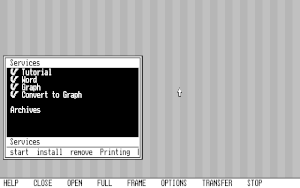Visi On

Visi On Applications Manager
|
|
| Developer | VisiCorp |
|---|---|
| Working state | Discontinued |
| Source model | Proprietary |
| Initial release | December 16, 1983 |
| Latest release | 1.0 / December 16, 1983 |
| License | Proprietary |
VisiCorp Visi On was a short-lived but highly influential graphical user interface-based operating environment program for IBM compatible personal computers running MS-DOS. Although Visi On was never popular, as it had steep minimum system requirements for its day, it was a major influence on the later development of Microsoft Windows.
In the spring of 1981, Personal Software was cash-flush from the ever-increasing sales of VisiCalc, and the corporate directors sat down and planned out their future directions. Ed Esber introduced the concept of a "family" of products that could be sold together, but from a technical perspective none of their products were similar in anything but name. For instance, to use VisiPlot with VisiCalc data, the numbers to be plotted had to be exported in a "raw" format and then re-imported.
Dan Fylstra led a technical discussion on what sorts of actions the user would need to be able to accomplish in order for their products to be truly integrated. They decided that there were three key concepts. One was universal data exchange, which would be supported by a set of common data structures used in all of their programs. Another was a common, consistent interface so users would not have to re-learn the UI as they moved from one program to another. Finally, Fylstra was concerned that the time needed to move from one program to another was too long to be useful – a user needing to quickly look something up in VisiDex would have to save and exit VisiCalc, look up the information, and then quit that and re-launch VisiCalc again. This process had to be made quicker and simpler.
In July 1981 Xerox announced the Xerox Star, an advanced workstation computer featuring a graphical user interface, and by that point it was a well known "secret" that Apple Computer was working on a low-cost computer with a GUI that would later be released as the Apple Lisa. Personal Software's president, Terry Opdendyk, knew of a two-man team in Texas that was working on a GUI, and arranged for Scott Warren and Dennis Abbe to visit Personal Software's headquarters in Sunnyvale, California. They demonstrated a version of the Smalltalk programming language running on the TRS-80 microcomputer, a seriously underpowered machine for the task. Personal Software was extremely impressed.
...
Wikipedia
